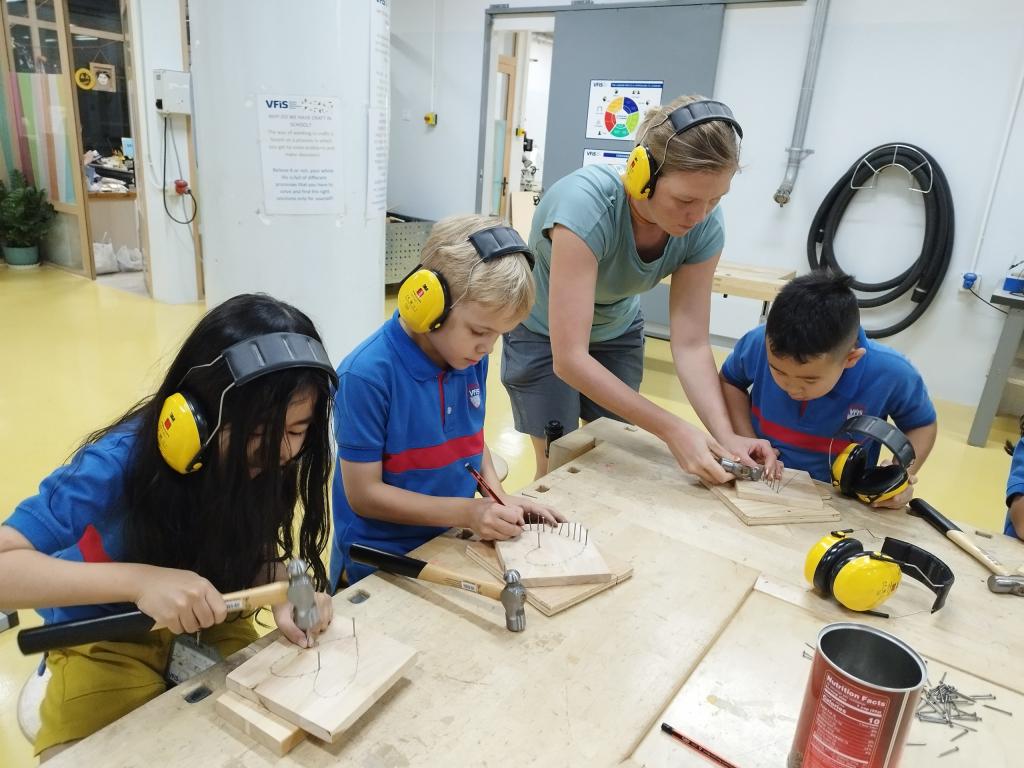Study Crafts at VFIS
History and the present time
The pedagogical craft was born during the second half of the 19th century in Sweden and Finland. In the beginning, it was strictly divided into separate crafts for men and for women. The focus was mainly on producing necessities for the household, such as wooden bowls and cutleries or aprons and bed linen.
When the elementary school system in Finland was founded in 1912, the focus moved more to educational and pedagogical aspects, but there was still a demand for producing products for home needs, especially after the tough war years before the 1950s.
When a new curriculum was founded in 1970, there was a need for renewing the subject. The female and male craft was now called textile craft and technical craft, which refers to the materials and techniques that are used in the specific craft type. In the beginning, the craft was taught mainly by a principle where students copied specific strictly chosen products, for example, a doll or a wooden spoon. The subject was now getting a more unisex and creative character, where students could be their own designer and the focus was more on the process, not the product itself.
Today, the craft is taught commonly as a subject, where there is no distinguishing between technical and textile materials and techniques. The subject is taught in Finland as a mandatory subject for grades 1-7 and as an elective subject in grades 8 and 9. Some high schools offer Crafts courses and give the opportunity to accomplish a Crafts diploma.
Working methods and environments at VFIS
Crafts at VFIS is taught in a combined textile and technical classroom. Some classes are taught by two teachers. Some crafts processes are focusing sometimes on either textile work or technical work, sometimes they are combined. The materials consist mainly of hard materials like wood and metal and soft materials like fabric, threads, and yarn. New techniques, such as 3D printing and CNC techniques are also a part of some entities.
The crafts process is commonly built around a specific theme or technique. The students plan their craft process according to certain given assessment criteria and limits. Self and peer assessment is commonly used during and at the end of the working process. Students document their process with pictures and descriptions in physical notebooks or in an electronic platform.

The contents, objects, transversal competencies, and interdisciplinary modules in the curriculum give frames for the process and can differ in different grade levels. Some processes are based on a specific holiday or a core school value or theme during the school year.
Contents
C1 Producing ideas
C2 Experimentation
C3 Design
C4 Production
C5 Documentation
C6 Assessment
Why should students learn Crafts and what is the subject's role today?
As mentioned, crafts have become more of a pedagogical subject than a subject based on practical and beneficiary needs.
The changes in society have clearly changed the meaning of crafts and handicraft skills. According to researchers, future pedagogical crafts should focus more on transversal competencies, life skills, and coping in a global world.
After all, the need for handicraft skills has not vanished. In many countries, there is already today a severe shortage of handicraft professions. In a world where we can buy anything for less and less money and a “tear and throw away”-thinking makes Crafts very important. In this subject, we learn about materials and products life cycles and how to produce ethically and environmentally sustainable products, as well as producing durable products and learn how to repair and restore products instead of throwing them away.
.jpg)
Facts about crafts:
Being a perfect counterweight to many theoretic subjects in school, Crafts make us feel better and help us concentrate. There are studies that prove the positive psychological effects of practicing crafts.
By doing and working with your hands you will learn a lot about yourself! Which are my features? It's very important that you know yourself and recognize your strengths and also weaknesses!
The way of working in crafts is based on a process in which you get to solve problems and make decisions! Life is full of different processes that you have to solve and find the right solutions only for yourself!
When you work with your hands you activate both brain halves together with your hands.
Yes, you will need all these skills in many occupations, for example as a surgeon, a construction worker, or a mechanic.
Crafts can open new doors for your life and future, new hobbies, and even a future occupation.





